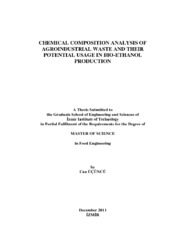Please use this identifier to cite or link to this item:
https://hdl.handle.net/11147/3160Full metadata record
| DC Field | Value | Language |
|---|---|---|
| dc.contributor.advisor | Tari, Canan | - |
| dc.contributor.author | Üçüncü, Can | - |
| dc.date.accessioned | 2014-07-22T13:51:00Z | - |
| dc.date.available | 2014-07-22T13:51:00Z | - |
| dc.date.issued | 2011 | - |
| dc.identifier.uri | http://hdl.handle.net/11147/3160 | - |
| dc.description | Thesis (Master)--Izmir Institute of Technology, Food Engineering, Izmir, 2011 | en_US |
| dc.description | Includes bibliographical references (leaves: 69-77) | en_US |
| dc.description | Text in English; Abstract: Turkish and English | en_US |
| dc.description | xi, 82 leaves | en_US |
| dc.description.abstract | Between the year 2000 and 2008 the amount of fruits and vegetables used in fruit juice industry were 4918400 tons in Turkey. Thus, % 15-30 of a fruit is pomace, high amount of pomace appears as waste in fruit juice industry every year. Some of these pomaces could be candidates as potential fermentation media for bioethanol production. The aim of this study was in first step the optimization of the hydrolysis conditions using statistical methods and then the selection of the best hydrolysate for bioethanol production using the fungus Tricoderma harzianum. In the optimization study the factors were temperature, time, solid liquid ratio and acid percentage whereas the responses were furfural, hydroxymethylfurfural, glucose, xylose, galactose, arabinose and total reducing sugar yield. According to the results of the screening process, the hydrolysis step was carried out at a temperature and time of 126 ï‚°C, 40 min for apricot pomace and 110 ï‚°C, 40 min for peach and apple pomace. In the optimisation step and levels of the other factors were enlarged. The highest reducing sugar yield during optimization was 31% for apple, 49.16% for apricot and 52.44% for peach pomace. These results indicated that these pomaces hold certain potential for bioethanol production. Three different incubators (CO2, static and non-static) were used for the fermentation process. Tricoderma harzianum grown aerobically in two different media (YPM and YNB) inoculated in apple hydrolysates was used in each incubator for bioethanol production. The highest ethanol production was 1.67g/L in non-static incubator with the culture grown in YNB media. | en_US |
| dc.language.iso | en | en_US |
| dc.publisher | Izmir Institute of Technology | en_US |
| dc.rights | info:eu-repo/semantics/openAccess | en_US |
| dc.subject.lcsh | Agricultural wastes as fuel | en |
| dc.subject.lcsh | Waste products as fuel | en |
| dc.subject.lcsh | Biomass energy | en |
| dc.subject.lcsh | Alcohol as fuel | en |
| dc.title | Chemical Composition Analysis of Agroindustrial Waste and Their Potential Usage in Bio-Ethanol Production | en_US |
| dc.type | Master Thesis | en_US |
| dc.institutionauthor | Üçüncü, Can | - |
| dc.department | Thesis (Master)--İzmir Institute of Technology, Food Engineering | en_US |
| dc.relation.publicationcategory | Tez | en_US |
| dc.identifier.wosquality | N/A | - |
| dc.identifier.scopusquality | N/A | - |
| item.languageiso639-1 | en | - |
| item.openairetype | Master Thesis | - |
| item.cerifentitytype | Publications | - |
| item.openairecristype | http://purl.org/coar/resource_type/c_18cf | - |
| item.fulltext | With Fulltext | - |
| item.grantfulltext | open | - |
| Appears in Collections: | Master Degree / Yüksek Lisans Tezleri | |
Files in This Item:
| File | Description | Size | Format | |
|---|---|---|---|---|
| T000973.pdf | MasterThesis | 1.39 MB | Adobe PDF |  View/Open |
CORE Recommender
Page view(s)
252
checked on Jul 7, 2025
Download(s)
126
checked on Jul 7, 2025
Google ScholarTM
Check
Items in GCRIS Repository are protected by copyright, with all rights reserved, unless otherwise indicated.